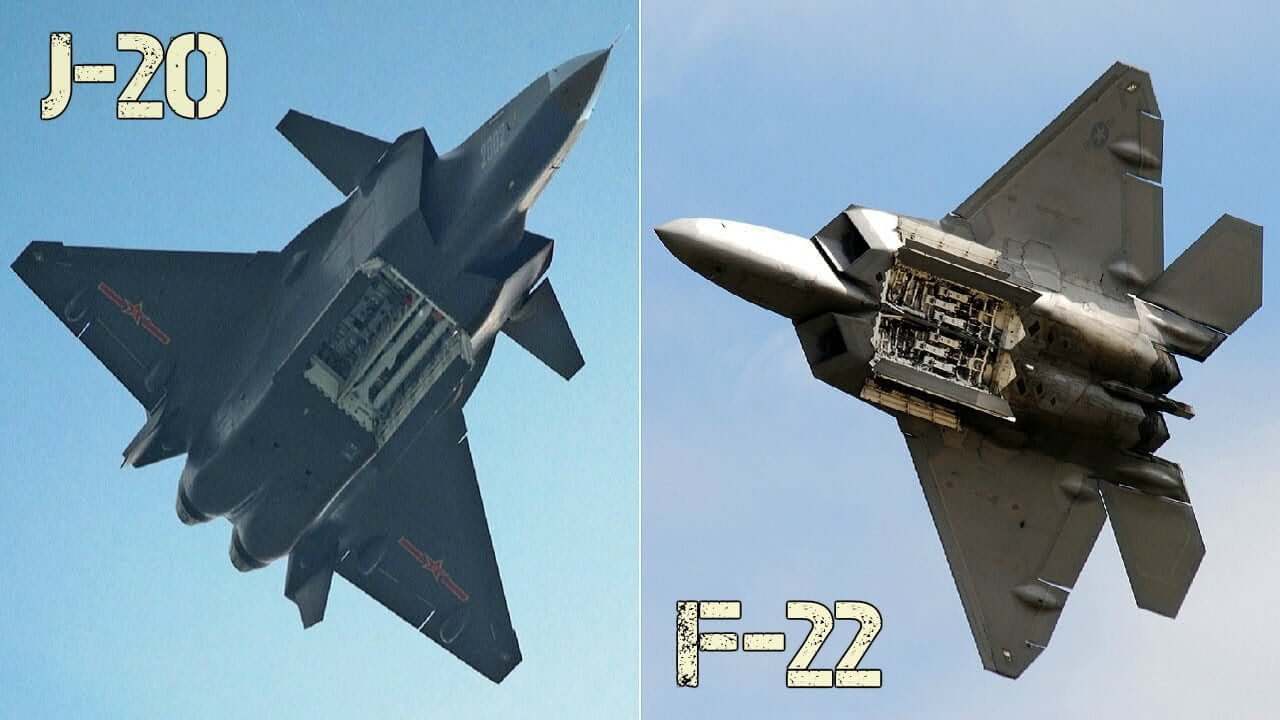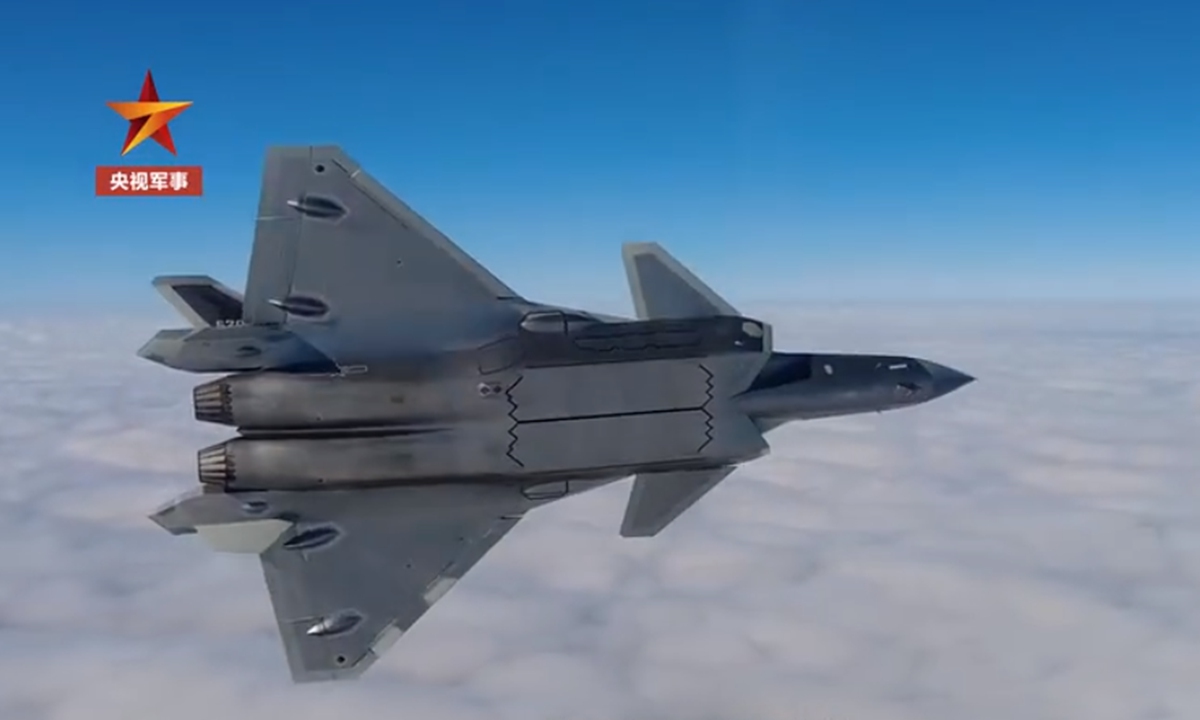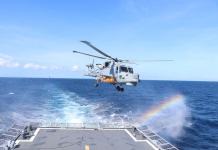With China increasing its military drills around Taiwan amid a possibility of actual military action, the risks of a face-off with the US are high.
After China employed its fifth-generation J-20 stealth fighter for the first time in the ongoing live fire drills, it could lock horns with one of its prime contenders in the US Air Force (USAF) arsenal – the F-22 Raptor. The other is the F-35 Lightning II.
EurAsian Times reported that the US used a dozen F-22s and four F-35s in exercises with Japan. It was in response to growing Russian and Chinese “strategic coordination military flights” over the Sea of Japan and other naval maneuvers.
F-22 ‘Raptor’ Vs. J-20 ‘Mighty Dragon’
Developed by Lockheed Martin, the Raptor came into service in 1997, with the final delivery in 2012, with around 187. It is a pure, full-stealth air dominance fighter with little ground attack capability, which the USAF found poorly needed around 2009.

This was during the height of the US’ global war on terror, where there were no air-to-air missions. The USAF then briefly toyed with retiring the jet but retained it after seeing the J-20s entry.
The F-22 is smaller at 62 feet and has pitch-directional thrust-vectoring Pratt and Whitney F-119-100 engines with rectangular slits as exhausts.
They can push it to Mach 2 speeds (2,469 km/hour), fly for 799 kilometers without external fuel drop, and 2,962 kilometers with refueling while reaching a maximum service ceiling of 50,000 feet.
The Pratt and Whitney engines are some of the best in the world that give the Raptor super-cruise capability, where it can reach supersonic speeds without engaging afterburners. This expends less fuel and reduces infrared signature, which enemy airborne, ground-based, and missile sensors cannot detect.
It has three weapons bays concealed with retractable doors – one large main bay at the bottom of the fuselage along the centreline and two smaller bays aft the engine intakes.
While it can carry its primary air-to-air missiles like the AIM-120D Advanced Medium Range Air-to-Air missile (AMRAAM) and the AIM-9X sidewinder in all the bays, air-to-ground ordnance can only be carried in the main bay, by having to swap out AAMs.

It is reported to be able to carry six AIM-120Ds. This represents the first weakness of the F-22, where it cannot perform multi-role missions. The bay doors open for less than a second for missile launches.
It has a 160 kilometers range AN/APG-77 solid-state Active Electronically Scanned Array (AESA) radar, superb sensor fusion, and data links. But it’s gold-standard is maneuverability and kinematic performance, bringing it at par with Russian Sukhoi jets in dog fighting.
Its defining feature is its pure ‘all aspect’ stealth. It is not considered to fall in the ‘low observability’ category. This also makes it costlier to maintain with higher life-cycle costs, with reports and pictures of its special radar absorbent coating coming off.
J-20’s Advantage Over F-22 Raptors
On the other hand, the Chengdu Aircraft Corporation’s J-20 is a delta-wing fighter. It is believed to be poor in kinematic performance, primarily due to the Chinese struggling with its domestically developed WS-15 jet engine.
The niche technology is only possessed by the United States, United Kingdom, France, and Russia. Its front-swept back steerable canards allow some superb maneuverability by breaking airflow. Still, some experts believe this also compromises stealth by giving a more excellent surface for radar emissions to bounce off from.
It was initially powered by the Russian AL-31F turbofans and the WS-10C engines later. Larger at 69 feet and without a powerful engine and thrust-vectoring nozzles, many believe the J-20 cannot perform the gut-wrenching tight maneuvers in a dogfight, which cedes the advantage to the F-22 in this domain.
Its stealth technology is believed to have been acquired from the F-35 Lightning II program via cyber-attacks and hacking of computers of private US defense contractors.

However, what the J-20 lacks in kinematic performance and speed is believed to make up for even advanced electronics, primarily a Luneburg lens. It is a small device used to intentionally expose stealth fighters to friendly forces during exercises, which indicates that even J-20’s actual stealth features are not yet known.
It has two more advantages that the F-22 lags in – a helmet-mounted display for pilots and the range of its Beyond Visual Range (BVR) missiles.
The J-20 carries the PL-15, the world’s longest range BVR that can reach distances over 300 kilometers. Its HMD also provides its pilots with an ergonomic advantage of not having to keep looking at the screen displays in the cockpit as all the readings are directly beamed onto their helmet visor.
It eases the stress of flying, particularly in contested complex battlespace situations.
Moreover, the F-22 is also missing an Infrared Search and Track (IRST) that cued to the radar can aid medium-range detection. A program to integrate an IRST onto it was kicked off only earlier this year.
Who Wins – F-22 Raptor or J-20 Mighty Dragon?
The J-20’s speculated weakness in dogfighting assumes that the Chinese designed it for that purpose. EurAsian Times had reported how experts believe it might be used in sniping modes with its latest radars, data-linking, and sensor fusion.
Slipping past fighter screens using its stealth and jamming capability, it can take out vulnerable assets like the E-2D Hawkeye early warning aircraft and aerial refueling KC-46 tankers that leave US fighters like the F-22 without both range and detection.
It aligns with the overall Chinese anti-access/area-denial (A2/AD) doctrine of using ultra-long-range missiles to hit enemy targets without allowing them to get close. The ‘carrier-killer’ DF-21D Anti-Ship Ballistic Missile (ASBM) is the most significant manifestation of this thinking.
China’s perception of the future war being information intensive is reflected in its ‘intelligentized warfare’ concept, where the pilot uses information with enhanced data-linking and situational awareness, Artificial Intelligence (AI) in an observe-orient-decide-act (OODA) loop in the air combat decision-making.
“Intelligence becomes the deciding factor” in an “OODA 3.0”, the J-20’s designer Yang Wei wrote in a paper published in the Acta Aeronautica Sinica, a Chinese defense journal.
Chinese military aviation expert Rick Joe says in The Diplomat, “Its kinematic performance even with interim engines must be considered with its aerodynamic design, and its overall combat role must consider its stealth, sensor fusion, data-linking, and weapons.”
Lastly, it also comes down to the number of F-22s manufactured, whose production lines have stopped. China is far from closing the newly introduced J-20s, possibly introducing even advanced variants in the future.
The difficulties with the WS-15 engines will have been solved by then, with the J-20 matching the F-22 Raptor or even Su-35 in kinematic performance.
EurAsian Times had reported General Kenneth Wilsbach, Commander of the Pacific Air Forces, saying he was “impressed with the command and control associated with the J-20” when US F-35s happened to get relatively close to the J-20s in the East China Sea.
The F-22 Raptors will not hunt alone. They will have heavy-duty F-15EX fighters and F-35 ‘flying computers’ with them, which gives US Air Force a massive advantage over other powers.
- The author can be reached at satamp@gmail.com
- Follow EurAsian Times on Google News




